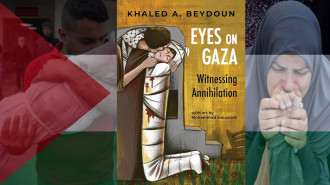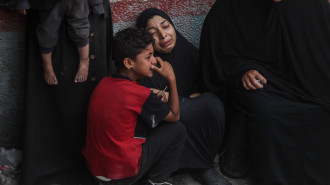
Revisiting Palestinian rap and its evolution with Asifeh and Osloob

Rap has become a huge phenomenon in Arab countries in the past few years. With headliners coming from Morocco to Lebanon, the genre and the hip-hop scene as a whole, are now a part of the mainstream culture in Arab countries.
If you were to search specifically for Palestinian rap, you would quickly find that the focus is on young artists, like Saint Levant and Shabjdeed, who are making phenomenal waves in the music scene.
However, hip-hop and rap have been present in Palestine since the late 90s, making it one of the oldest rap scenes in the Arab region.
By mostly covering artists from the past five to seven years, a lot of media coverage has forgotten the rich history of the Palestinian rap scene, including artists who first initiated the movement from scratch between the end of the nineties and the beginning of the 2000s — including DAM, Palestinian Rapperz, Ramallah Underground, and the duo Arapeyat.
Ramallah Underground was one of the most famous hip-hop collectives of this time. They distinguished themselves thanks to their experimental style of rap and production.
Founded by high school friends Asifeh and Muqata’a, both began making music around the second Intifada, which directly affected their kind of music.
Listeners became strongly attracted to their rough way of capturing the reality of the ground. It allowed them to tour many cities in Europe, Australia, and Jordan between the early 2000s and 2009, a huge opportunity, especially for artists from this time.
On an individual level, Asifeh started to write lyrics about what he was seeing daily in Ramallah such as checkpoints, bombings, tanks, or the curfews they went through for days or sometimes months, heard in soundtrack like Sijen ib Sijen.
“Wherever I go in this cage, I can’t breathe.
One more dead, one more in jail, one more beaten with a club.
What’s going on? There’s no explanation
All I see is tear gas.
Prohibited from doing what I want.
They expect me to forget about living.”
“From the beginning, the Western media has tried to describe us in a 'Palestinians dropped their weapons and started rapping' or a 'Look, they have culture, they don’t just shoot' kind of way. This orientalist approach was a way to reduce our struggles," Asifeh tells The New Arab about the media coverage of the Palestinian rap scene.
"Besides, Western media only wants to portray the same artists," the now Vienna-based rapper and producer continues.
"For example, they often focus on artists who have a good economic situation, speak good English or go to international schools. Their ideal artist must be close to their Western projection and is more acceptable in their eyes.”
Osloob, a Palestinian rapper and producer born in camps in Lebanon also shares this perspective.
Known as one of the members of the pioneering hip-hop group Katibeh 5, Osloob has been producing music and rapping for as long as he can remember.
What started as sampling the tunes played on his radio in the camps, later became his career.
His beginnings in this hostile environment left a mark on his style of rap: a raging sound influenced by both Egyptian classic music and the flow of members from the Wu-Tang Clan, followed by sharp lyrics pointing the finger at anyone corrupt.
From his 25 years of experience, he affirms that the disparity between the reality on the ground and the media coverage had and continues to have a huge impact on artists.
“The issue isn’t new; it just got bigger with time," he tells The New Arab.
"Some media outlets don’t do their research and don’t care about who is different. It harms the scene because many artists become invisible.
"If you look at the US scene, for example, you can find diverse kinds of rappers. There is no such thing as Palestinian rappers in the media. Journalists only look for their projection of what 'real Palestinians' are. But what does it even mean to be a 'real Palestinian'?”
The birth of rap in Palestine came from a place of urgency. Like many people from all over the world, Palestinian rappers were influenced by the dominating US rappers, especially the politically committed kind.
If you dig into early artists from the Palestinian rap scene, you will find an astonishing diversity of sounds, that merge in the same US “old school” or “boom bap” genres that got famous thanks to figures such as RUN DMC, the Wu-Tang, J Dilla and Pete Rock.
The production style was enriched by various sampling techniques as well as the use of percussive sounds and reverb or the aggressive flow they adopted —whether it was the group MWR that both Osloob and Asifeh refer to as an influence, the famous DAM, Khalifa E, or the duo Arapeyat.
What made this period even more special was that the artists' main goal was to share a message with the world and the Palestinian cause or just the daily lives of Palestinians dominated the lyrical theme.
Meanwhile, in the past few years, new kinds of rap have emerged.
“It’s not about politics as much as it used to be," Asifeh explains.
"Rappers have also started to sing meaning that the format has changed and lost some of its important elements. I feel that some things have gone backwards because rap has started to become superficial and commercial. And this is not specific to Palestine, it’s the same path in the whole Arab region," Asifeh adds.
Back in the 2000s, Asifeh and Muqata’a used to publish music online at a time when blogs like MySpace didn’t exist.
Just like Osloob and his pioneering group Katibeh 5, they still successfully built a career through their website, by sending MP3s to friends and DJs and then publishing on Soundcloud or YouTube.
Artists from this time built the foundation for everything that came afterwards in the rap scene. Not only did they create space for the next generation of Arab hip-hop artists, but they also showed that many people are interested in what Palestinians have to say.
This resonates even more today as Israel's genocide in Gaza rages on.
Digging into the numerous kinds of rappers present for more than twenty years allows us, listeners, to understand that this cause has and will always exist, and that art is a way of preserving these precious narratives.
Emilie Maksaymous is a music journalist specialising in MENA and Black-American music (soul, neo-soul and R&B). She is fluent in English, French, and Arab, and has two years of experience in print and radio journalism


![Osloob [Paul Rousselet]](/sites/default/files/2024-09/IMG-20240823-WA0003.jpg)



 Follow the Middle East's top stories in English at The New Arab on Google News
Follow the Middle East's top stories in English at The New Arab on Google News


